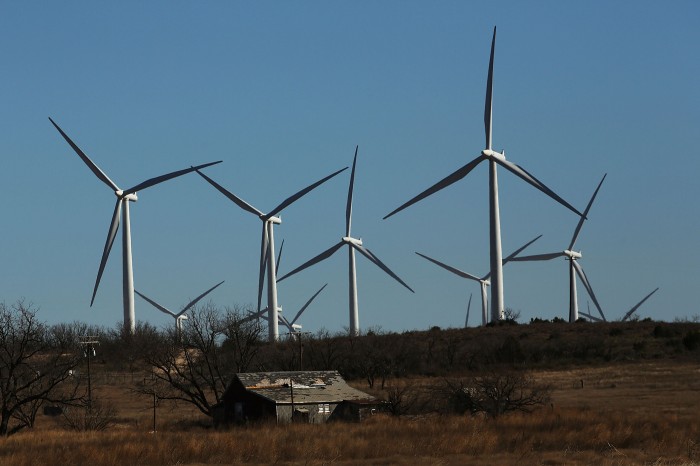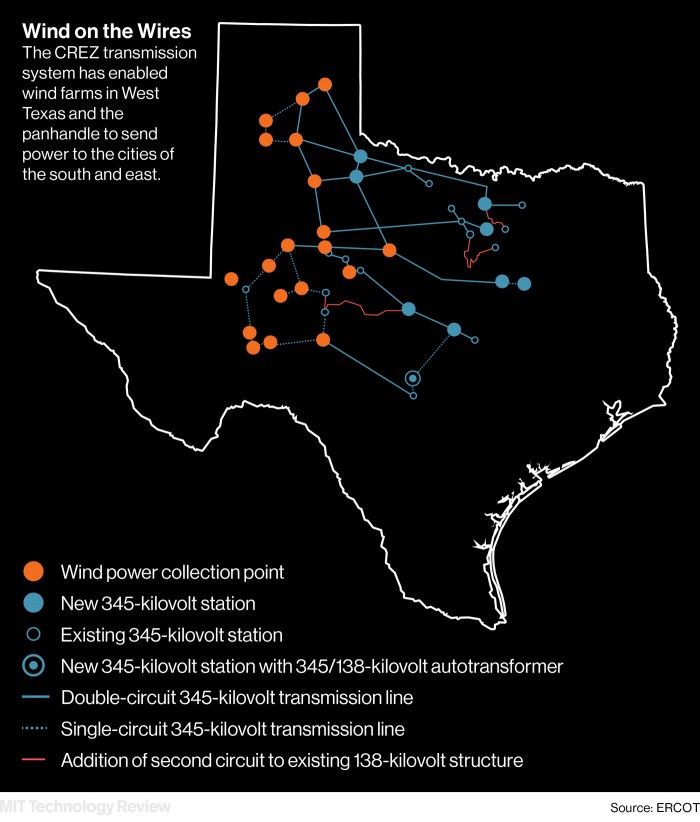In Texas Oil Country, Wind Is Straining the Grid
Texas is learning just how costly it is to wrangle the wind.
The Lone Star state is by far the largest state for wind power, with nearly 18,000 megawatts of wind generation capacity already built and another 5,500 megawatts—nearly equal to California’s total installed capacity—planned. The biggest driver of that wind boom was an $8 billion transmission system that was built to bring electricity from the desolate western and northern parts of the state to the big cities of the south and east: Dallas, Austin, San Antonio, and Houston.
Completed in 2014, the new wires—known as Competitive Renewable Energy Zones, or CREZ—have the capacity to carry some 18,500 megawatts of wind power across the state. That’s not enough to handle the 21,000 megawatts of capacity Texas expects to reach this year, and it’s creating a situation that’s straining the transmission system and potentially resulting in periods where the turbines go idle.
Now the state’s utilities and transmission companies are faced with spending hundreds of millions more to upgrade the system, demonstrating just how costly and complicated it is to shift from fossil fuels to renewable sources of energy, even where those sources are abundant.

EDF Renewable Energy, which owns five wind farms in northern Texas, and other operators have proposed adding second lines to existing transmission lines from the panhandle, where much of the new wind-farm construction is happening. Doing so, EDF says, will accommodate nearly 4,000 megawatts of new generation expected in the panhandle over the next several years.
“If some of these projects get developed in the panhandle and they haven’t done the upgrades to the grid, for sure those farms will be curtailed,” says Frank Horak, the CEO of Austin-based energy consultancy Astek Energy.
The wind industry is also expanding rapidly in the Rio Grande Valley, in far south Texas. The $300 million Cross Valley Project will bring power from wind turbines along the coast, near the border with Mexico, to fast-growing communities along the Valley.
Some operators and project developers have complained that getting authorization for future expansions will be too costly and time-consuming. “Some of the renewable energy folks are making it sound like the world’s coming to an end,” says Kenneth Anderson, one of the three members of the state’s Public Utility Commission. In fact, future transmission projects will have to prove they are economically viable and/or necessary to maintain the grid’s reliability. The original CREZ system granted a blanket authorization by legislators in Austin; going forward, future projects will have to be approved on a case-by-case basis.

Another looming challenge is an expected surge in solar projects in Texas. The state ranks third in terms of total solar capacity, and another 6,000 megawatts of solar projects are planned. That will further strain the grid.
“Last time I looked there were 42 solar projects in far West Texas that were in the interconnection queue waiting for new transmission because there’s a bottleneck there now,” says Horak. Most of those projects will remain on hold until new wires are in place; some may never be built.
What’s not waiting is demand growth. The population of Texas is expected to grow from around 27 million today to 33.6 million in 2030, with much of that coming in cities like Dallas and Austin. That means more wind and solar farms will be built in the coming years, and they’ll need more wires to transport the electricity they produce.
And that’s just in Texas. Xcel Energy said in June it plans to build a 240-mile, $400 million line to take wind power from Texas west into New Mexico. Texas wind will soon be lighting homes across the Southwest.
Keep Reading
Most Popular
Large language models can do jaw-dropping things. But nobody knows exactly why.
And that's a problem. Figuring it out is one of the biggest scientific puzzles of our time and a crucial step towards controlling more powerful future models.
How scientists traced a mysterious covid case back to six toilets
When wastewater surveillance turns into a hunt for a single infected individual, the ethics get tricky.
The problem with plug-in hybrids? Their drivers.
Plug-in hybrids are often sold as a transition to EVs, but new data from Europe shows we’re still underestimating the emissions they produce.
Stay connected
Get the latest updates from
MIT Technology Review
Discover special offers, top stories, upcoming events, and more.